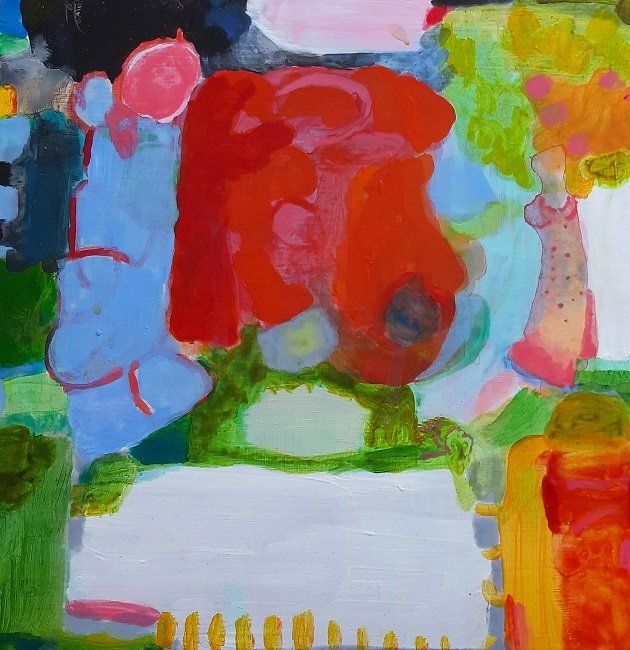Mary A. Fitzgerald
'Lamb's Tongue'
A closer look by Maisie Greener, volunteer at Olivier Cornet Gallery
In early April 2023, Maisie Greener, a volunteer at the Olivier Cornet Gallery, wrote about Mary A. Fitzgerald’s ‘Lamb’s Tongue’, a vibrant 25x25cm acrylic on board piece (580 euro)
"On an ostensible level, I was initially surprised by the piece’s platforming in the Bloomsday Summer group show as the striking and strong colours contrast the bleakness and monotony I typically associate with censorship and suppression. However, in Mary’s own words, Lamb’s Tongue’s inclusion in ‘Outrageous, Obscene and Offensive’, can be contextualised as a representation of ‘the lascivious and scatalogical nature of themes within Ulysses’ which appear to Mary as ‘visceral, playful and raw’. ‘For this painting I considered the interpretations of censorship and obscenity. The human head is a creative site, and the mouth which houses the tongue creates language, spoken word and song’. It is clear that Mary’s piece is not only an auxiliary in the battle against censorship, but fights on the frontlines.
Mary herself reveals her preoccupation with the process of revealing and concealing the narrative, maintaining that this action creates individual archaeologies and histories within each piece. The abstract arrangement of shapes and strokes appear simultaneously deliberate and organic; with approximate outlines between colours drafted but not scrupulously adhered to. The variance in opacity seems to mirror Mary’s artistic methodology, whereby layers and elements comprise and conceal a whole.
Usually Mary’s work entails intimations about place and object while incorporating private sensations and experiences. Her iconography is rooted in the quotidian but notes how memory and recollection affect and modify these encounters. The overlapping of paint complements Mary’s philosophy that past experiences compound to affect the present.
Her chosen palette of red, blue and green hues almost challenge censorship chromatically. By utilising shades that should not work together, washing stains of pink over green, for example, Mary subverts colouring precedent: resisting aesthetic censorship.The colours should be jarring and irksome however Mary navigates this mismatch through the amorphous, irregular shapes with softened and rounded edges. Mary’s depiction of the human head’s hub of artistry appears stimulating, dynamic and invigorating rather than antagonistic, belligerent and contentious. The nebulous forms reflect thoughts that have been allowed to develop sans censorship and obstruction. Even the more similar strokes, principally the yellow dashes along the bottom of the gesso board, vary in length and thickness, resisting conformity. The piece is entirely and unequivocally liberated from censorship and regulation. Additionally, the piece’s small size, measuring at 25cmx25cm, almost concentrates the resistance, packing even more of a punch.
Despite being aesthetically attracted to the piece, I was particularly drawn to its meaning. Titularly, Mary discerned the innocent and pure connotations of ‘Lamb’, evoking fragility and newness. ‘Tongue’ however, to me, excites activity and pace. The two appear paradoxical and consequently open themselves up to multiple interpretations. When read in the curatorial context of the Bloomsday exhibition, Mary is perhaps suggesting that the impressionable and young are perceived, by agents of censorship, as being invited to participate in perceived obscenity; although this is only alleged impropriety and is essentially just an exercise of autonomy and creativity. Nonetheless, the open-endedness of her title, as noted by Beth O’Halloran, ‘invites the viewer to complete the narrative within the soft edges of the work’. Perhaps collaboration between the viewer and the artist is the best remedy against censorship.
‘Swoon’, a key player from Mary’s catalogue, and a nod to her 2022 solo show, was recently included in ‘2012-2022, a decade of exhibitions at the Olivier Cornet Gallery’, celebrating Mary’s contributions both to the gallery and the Irish contemporary art scene. Mary’s work was also included in ‘Memento’, a Winter group show with underlying themes of climate change and the environment, the refugee experience and human resilience. By this engagement it is evident that Lamb’s Tongue’s interaction with social and salient issues is not anomalous."
Maisie Greener

